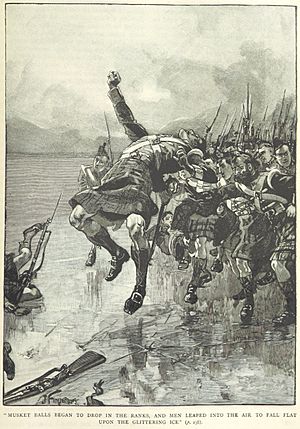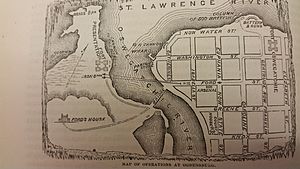Battle of Ogdensburg facts for kids
Quick facts for kids Battle of Ogdensburg |
|||||||
|---|---|---|---|---|---|---|---|
| Part of War of 1812 | |||||||
 The Glengarry Light Infantry attacks across the frozen river during the Battle of Ogdensburg. |
|||||||
|
|||||||
| Belligerents | |||||||
| Commanders and leaders | |||||||
| George MacDonnell | Benjamin Forsyth | ||||||
| Strength | |||||||
| 520 | about 250 | ||||||
| Casualties and losses | |||||||
| 6 killed 44 wounded |
20 killed 6 wounded 70 captured |
||||||
The Battle of Ogdensburg was a fight during the War of 1812. In this battle, the British army won against the Americans. They captured the village of Ogdensburg, New York. Even though it was a small battle, it was very important. It stopped the American threat to British supply routes for the rest of the war.
Contents
Why Did the Battle Happen?
When the War of 1812 started, a lot of secret trading began. This trading happened between Ogdensburg in New York and Prescott in Canada. Both towns were located on the Saint Lawrence River.
American Actions Before the Battle
In October 1812, the Americans tried to stop this trading. They sent more soldiers to Ogdensburg. These soldiers included the 1st U.S. Rifle Regiment led by Major Benjamin Forsyth.
The British militia tried to attack Ogdensburg on October 3. But the American soldiers quickly pushed them back. After this, Forsyth's riflemen often crossed the river. They would shoot at British soldiers from a distance. They also sometimes captured boats full of supplies heading to Kingston, Ontario.
British Plans for Attack
On February 21, 1813, Lieutenant General Sir George Prevost visited Prescott. He was the main leader of Canada. He brought more soldiers with him. Prevost put Lieutenant Colonel "Red George" MacDonell in charge of the British troops in Prescott. He told MacDonell to attack Ogdensburg only if the Americans had fewer soldiers there.
MacDonell used the extra soldiers he had for a short time. He made a plan to attack Ogdensburg. One group of soldiers would attack the fort directly. This group included the Glengarry Light Infantry and some local militia. They also had light guns on sleighs.
The main British group would cross the river further down. They would attack the town from the side. This group had soldiers from the 8th (King's) and the Royal Newfoundland Fencibles. It also included many local militia soldiers.
The Battle Begins
The Americans were used to seeing British soldiers practicing on the frozen Saint Lawrence River. So, they were surprised when the British suddenly charged. The riflemen in the fort fought hard against the direct attack. The British guns got stuck in the snow, which helped the Americans. American artillery also fired at the British.
But the main British group started to surround the Americans. So, the American soldiers had to retreat and leave the town. The local militia soldiers went back into the civilian population. The American artillery kept fighting bravely until their leaders were wounded. After that, the British took control of the town.
What Happened After the Fight?
The British burned the boats and ships that were stuck in the ice. They also took away American guns and military supplies. Some private property was stolen, but later, some of the stolen items were returned.
Who Fought and Who Was Lost?
The British reported that six of their soldiers were killed. Forty-four were wounded. This included British regulars, Glengarry Light Infantry, and militiamen.
Lieutenant Colonel MacDonell said that 20 Americans were killed. He also reported that 70 Americans were captured. Many of those captured were wounded. An American report said they had 26 killed and wounded. About 60 were taken prisoner.
Soldiers on Both Sides
The British forces involved in the battle included:
- Royal Newfoundland Regiment
- 1st Regiment of Dundas County Militia
- 1st Regiment of Grenville Militia
- 2nd Regiment of Grenville Militia
- 1st Regiment of Leeds Militia
- 1st Regiment of Stormont Militia
- Glengarry Light Infantry Fencibles
What Happened Next?
After the British left, the Americans did not send soldiers back to Ogdensburg. The British were able to buy supplies from American merchants there. This continued for the rest of the war. It seems that many people in the Ogdensburg area supported the British or were against the war.
General Prevost was usually very careful. But he changed MacDonell's report to make it look like the attack happened because of his orders, not against them.
The religious leader of the Glengarry Light Infantry, Alexander Macdonell, is said to have joined the attack. He reportedly held a cross to encourage soldiers who were falling behind. Another religious leader, the Rev. John Bethune, also supported him.


